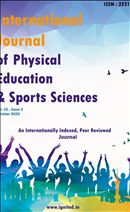Physiological Parameters with the throwing performance among the Softball Players
Main Article Content
Authors
Abstract
The primary purpose of the research is to analyze the relationship between softball players' physiological characteristics and their throwing performance. Philosophy conversations about how to increase performance are of interest to many in the sports world, including coaches, instructors, physicians, psychologists, and players. Softball is a worldwide phenomenon, with fans and players on every continent. When it comes to softball, relatively little study has been done on the many factors that continue to contribute to high performance. There is a lack of written information in the sport of softball, and many various aspects of the game need investigation and analysis. Sporting triumphs are rewarding for the athletes themselves, as well as for their families, communities, and countries. It's possible to lose games while spending a lot of time and energy coaching yourself and your squad. There has been a great deal of study on the factors that contribute to successful softball play and performance.
Downloads
Article Details
Section
References
- Lear, Aaron & Patel, Niraj. (2016). Softball Pitching and Injury. Current sports medicine reports. 15. 336-341. 10.1249/JSR.0000000000000293.
- Saraya, Arif & Sugiyanto, Sugiyanto & Doewes, Muchsin. (2018). Anthropometric Factors and Physical Condition Dominant Determinants Batting Skills in Softball. International Journal of Multicultural and Multireligious Understanding. 5. 213. 10.18415/ijmmu.v5i4.264
- Anwar, Choiroel & Budiono, Irwan & Pamot, Hermawan. (2019). Traditional Softball Games Effective Modified for Improving Nutritional Status and Physical Fitness in Elementary School Children. Jurnal Kesehatan Masyarakat. 15. 206-212. 10.15294/kemas.v15i2.21524
- Onose, Ionut & Abalasei, Beatrice & Onose, Raluca & Albu, Adriana. (2020). Appraisal of Motor Skills in a Sample of Students within the Moldavian Area. Behavioral Sciences. 10. 97. 10.3390/bs10060097.
- Bosquet, L. (2006). “Vmax estimate from three-parameter critical velocity models: validity and impact on 800 m running performance prediction”, Eur. J. Appl. Physiol, 97(1): 34-42.
- Buffi, J.H. (2014). “Computing Muscle, Ligament, and Osseous Contributions to the Elbow Varus Moment During Baseball Pitching.“ Ann. Biomed. Eng. Oct. 4.
- Cabello Manrique D (2003), “Analysis of the characteristics of competitive badminton.“ Br. J. Sports Med. 37(1): 62-6.
- Chauhan, M.S. (2004). “Prediction of Performance of University Throwers in Relation to their Anthropometric Measurements”, Journal of Sports and Sports Sciences, 27(3): 25-36.
- Delecluse, C., Diels, R. and Goris, M. (2003). Effect of Creatine Supplementation on Intermittent Sprint Running Performance in Highly Trained Athletes. Journal of Strength and Conditioning Research, 17: 446-454.
- Eston, R. and Reilly, T. (2008). Kin anthropometry and Exercise Physiology Laboratory Manual: Tests, procedures and data. Routledge
- Falk, B. (2004). “Talent identification and early development of elite water-polo players: a 2-year follow-up study”, J. Sports Sci. 22(4): 347-55.
- Faude, O. (2007). “Physiological characteristics of badminton match play.“ Eur. J. Appl. Physiol. 100(4): 479-85.
- Gamelin, F.X. (2006), “Prediction of one-hour running performance using constant duration tests.” J. Strength Cond. Res. 20(4): 735-9.
- Guillain, Jean-Yves (2004-09-02). Badminton: An Illustrated History. Publibook. p.47.

